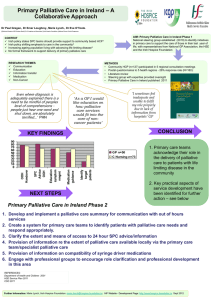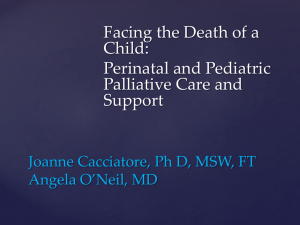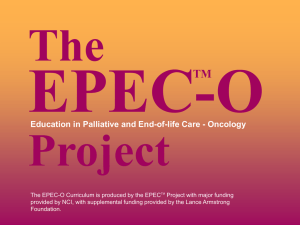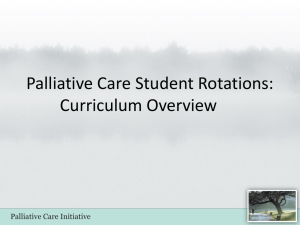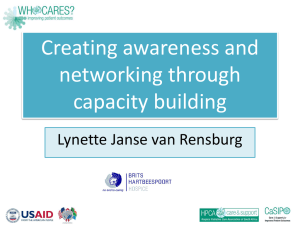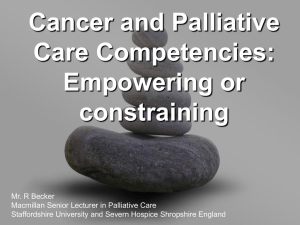Pediatric Palliative Care
advertisement
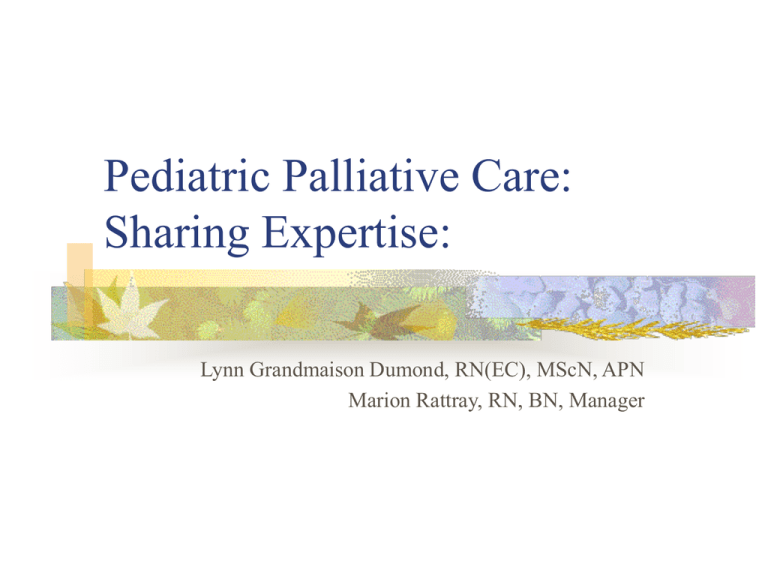
Pediatric Palliative Care: Sharing Expertise: Lynn Grandmaison Dumond, RN(EC), MScN, APN Marion Rattray, RN, BN, Manager Objectives Review the principles of pediatric palliative care Highlight the services offered by the CHEO Palliative Care Outreach Team Elaborate on approaches to teaching end-of life issues Present and discuss current information of Pediatric Palliative Care Guiding Principles of Pediatric Palliative Care Care centered on the child and his/her family Great importance placed on the therapeutic relationship continuity of care Communication Accessibility Ethical considerations What is Pediatric Palliative Care? Is an active, total approach, embracing physical, emotional, social and spiritual elements Focuses on the quality of life for the child/youth and support for the family Includes the management of distressing symptoms, the provision of respite and follow through of illness, death and bereavement. Provided when curative treatment is not, or is no longer feasible - may run parallel to active treatment Palliative treatment may extend over many years Why Different from Adults? Children are not little adults; there is a developmental component to the care Children are often born with life threatening conditions; may be on palliative care for their entire lives In contrast to adult palliative care, most children receiving palliative care do not have cancer The approach must be tailored to children, family and their special needs CHEO’s Outreach Palliative Care Program Goals Support of child, family and care team Advocate and Empower Collaborate, Communicate, Coordinate Provide Consistency and continuity Provide Expertise Educate, Participate in Research and Develop programming CHEO’s Outreach Palliative Care Program Services In house consultation and follow up Outreach Education, debriefing and support to professionals Pain and symptom management Bereavement support Assistance with ethical decision making Clinical Settings… Hospital/Institutional care CHEO and other regional referral centers Community care Roger’s House In-home acute palliative care and surveillance Roger’s House is… An 8 bed hospice for children An integral part of CHEO’s Pediatric Palliative Care Outreach Program A place where children and youth with progressive, life limiting illnesses are welcomed with their family and friends An environment where efforts are made to enhances quality of life of the child and support his/her family Services offered at Roger’s House Temporary respite (planned and emergency) Acute pain and distressing symptom management Holistic “end of life” care Temporary “transition to home” care Grief and bereavement care Barriers to Palliative Care The death of a child is inconceivable Terminology causes anxiety Topic is difficult to discuss Lack of knowledge late consultation Dichotomy b/w healing and death: success v/s total failure … Uncertain prognosis Family unwilling to accept the palliative nature of illness Language barriers and cultural differences Time constraints, lack of human resources Search for curative treatments Lack of services in palliative care … Lack of knowledge/discomfort with end of life care and treatments Conflicts regarding goals of treatment b/w family members b/w family members and team members b/w team members Important Principles Palliative Care does not hasten death and is not euthanasia Principles of palliative care can and should be integrated to acute and intensive care Care of the caregiver is extremely important (family and professionals) Complementary approach and services And… Most effective when offered by an interdisciplinary team Offered in the environment chosen by child and family One Case at a Time Consists of: Early consultation if possible Complete case review Therapeutic relationship set up Interdisciplinary intervention Implementation and frequent review of palliative plan of care One Family & Child at a Time Consists of: Flexible approach Open, honest, active approach Compassion and comprehension Respect of values, culture, spirituality Set up a community network Support in times of decision making Services offered conjointly One Professional at a Time Consists of: Collaborative approach Sensitize/mentor Support and care of the professional caregiver Elaborate the specialty Integration of services Respect of professionals beliefs, values… Outcomes! Collaboration Sensitization, ease of discussion, planning Respect, support and validation Positive memories and feelings Improved family coping Subject less “taboo” Resources for Pediatric Palliative Care CHEO Palliative Care Team Canadian Hospice Palliative Care Association (CHPCA) Hospice Association of Ontario (HAO) CPHPC Canadian Pediatric Initiative for Pediatric Palliative Care (IPPC) PedPallNet End of Life Network Education Consortium (ELNEC) Canadian Network of Palliative Care for Children
